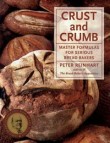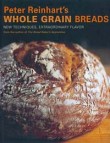Peter’s Blog, Sept. 15th, Cold Fermentation
He’s raised an interesting question: does long, cold, overnight fermentation create a flavor that would universally be considered superior; that is, an inarguable benefit? To answer this, I think, requires more than a simple yes or no, but an explanation as to what happens during the fermentation stage that would lead to the opinion that this is a way to improve flavor. We’ve discussed this here in the past, though in an abbreviated manner, so let me draw it out more completely and, hopefully, address Scott’s question at the same time.
My belief (and remember, this is just my opinion — no one owns the whole truth in these matters) is that the key to the value of long fermentation is the enzyme activity, in particular the alpha-amylase and beta-amylase action that slowly releases glucose, maltose, and other sugars from their starchy chains in the flour. This takes time, anywhere from 6 to 12 hours minimum, but it is not a biological fermentation since enzymes are not alive, they are simply part of the grain (protein fragments, but not living organisms, if I understand the chemistry of them properly, but then I’m no chemist). The process of sugar break-out from the starch is slower at colder temperatures but is not subject to the same rules as yeast and bacteria (which essentially go nearly dormant when they get cooler than 40 degrees F.). Anyway, pizza makers have known for a long time, whether by accident or intentionality, that their dough balls are better tasting and more beautiful to look at when used the following day (or even over a number of days, within reason) than if used on the same day in a fast rising method. It is not only because the fermentation is better in the slow method but, I believe, because more natural sugar has been evoked from grain by the enzymes and that improves both color and flavor, as well as providing new, ongoing food for the yeast and bacterial fermentation (so, in a way, it does elicit more fermentation flavor as well as releasing sugar). Bottom line: yes, Scott, I do believe long, cold fermentation improves flavor but, I have to say this too, it is not the only way to release flavor — that is, it is time more than coldness that is the key.
I say this because, as we discussed in the long comment thread a few weeks ago, Philippe Gosselin (and I’m sure others) uses a method that doesn’t require any yeast during the overnight period and, more importantly, pizza masters like Chris Bianco are able to achieve amazing flavor and texture by making their dough on the same day, not using any refrigeration. But in Bianco’s case, and others who can pull it off, the dough is made early enough in the day to allow the enzyme activity to occur without over-fermenting the dough by using a smaller amount of yeast. In other words, the “baking triangle” consisting of time, temperature and ingredients can be manipulated in many ways to achieve great results. Some methods and formulas might, for example, use a pre-ferment like a biga, poolish, or pate fermentee’ to add enzyme-evoked flavor in a shorter period of time.
So, to summarize, Scott123 is correct in asserting that long, cold fermentation achieves superior results to short, fast fermentation but let’s not forget the possibility of long, room temperature fermentation too, or the use of pre-ferments to shorten fermentation time (I won’t even touch the matter of commercial dough conditioners that spike the dough with added enzymes to speed things along — that’s another can of worms but one worth visiting in the future). If I’m not mistaken, Jim Lahey uses the room temperature method in his so-called “NY Times French Bread” method (and I believe also in his pizza dough — BTW, I think we should stop calling it the NY Times method and let Jim have it named after him, the Lahey method — I’m okay with that since he’s the one who first brought it to light and Jim is a good guy!). The fact that his French Bread dough sits overnight before going into a hot Dutch oven is for convenience more than because it is “overnight” — you could mix it in the morning and bake it at night just as easily; it is time, that very critical point on the baking triangle, that affects the flavor, as long as it is properly balanced by the other two corresponding points (ingredients = small amount of yeast; temperature = either cold or, possibly, ambient room temperature). For a pizzeria, though, it makes sense to work a day or two ahead for any number of reasons and, from what I observed at Pizzeria Bianco, it may simply be a matter of lack of space and refrigeration that necessitated the ambient method rather than a philosophical or anti-cold fermentation dough method. That is, we can almost always make the situation work to our advantage if we keep the three points on the “baking triangle” in the proper balance.
Okay, that’s my take on it — what do you all think?
Recent Articles by Peter Reinhart
- The Quest for the Top Rock Band Singers of All Time, with Guest Peter Scott Ruben
- Team Rose Bread, The Little Cottage Bakery That Could
- Two Chefs and Marketing Guru Walk Into a Bar (or, What the Freak is Pizza Freak: featuring Brad Daniels, Matt McKenney, and Brad Kilgore)
- Agostino Cangiano and Tatiana Revox, Slicehaus NYC
- “Sourdough” 10th Anniversary Edition with Author Sarah Owens
- The Cheese Dude Returns with His Mt. Rushmore of Cheeses You Must Try Before You Die
Add Comment
You must be logged in to post a comment.










MIke, I”ve always wondered the same thing. I think it probably comes out tasting the same regardless of the size of the dough mass. I skip the bulk ferment since when i pull the dough out of the mixer, it’s right there in front of me, ready to ball. It cools and warms up faster in that form too then a larger mass.
Scott raises an interesting point — does the cold fermentation affect the flavor by reducing certain biological activities — addition through subtraction in a sense. This is just a hunch, but I think this is more of a factor when long time lines are in play. I think it is definitely true for when using wild yeast (aka sourdough) starters. For example, Flemish desum starters are developed at cooler temperatures than most other methods and they provide great complexity without a lot of sour tang. But pizza doughs with commercial yeast, even if using a biga or poolish, are used within such a short period of time (within a few days at most) that any impact along the lines of the ale vs. lager analogy is probably less noticeable. To hold a dough for longer periods, as Scott suggests, would compromise the structure. So, where I think this idea could be truly tested is by using different types of wild yeast starters (based on temperature differences) in side by side comparison fermentations and tastings. If anyone decides to tackle this, I’d love to hear the results. Otherwise, we’re just speculating, though it’s a very interesting thought exercise.
As to Mike’s and Souspizzaiolo’s points, where I see pizzerias run into trouble with bulk fermentations is that the big dough batches take too long to cool down and they tend to over-ferment. If you use the cold, overnight method, the first fermentation takes place in the fridge, even if as a dough ball, and the second fermentation happens when you take the dough out and let it warm up prior to baking. With small batches, such as we do for home baking, a 3-pound batch for example, the bulk dough will cool down quickly enough to retain enough natural sugar for a second fermentation after balling the dough the next day (or for up to about three days) if retarded early in the process. One way to gain the benefit of both methods is to allow a bulk dough a moderate first fermentation at room temp (maybe one hour) and then ball it and retard it overnight. For a professional operation, this would have to be worked into the production pattern for consistency sake, and the danger would be that if an unexpected rush happens the team could lose control of the dough and wait too long before balling it and, thus, over-ferment it. Whew, it seems like there are so many valid ways to approach this; in the end, as long as you don’t over-ferment the dough the needs of the operation would probably dictate the best system — fortunately, dough is very forgiving and provides a fairly wide berth and margin for error, especially when working with small yeast percentages as most pizza doughs do.
I have a slightly different take on it. The claim that yeast and bacteria essentially go nearly dormant when they get cooler than 40°F is not really true. If you believe Michael Ganzle’s modeling results, both the yeast and the LAB slow down at low temperature, but the yeast slows down a LOT MORE than the bacteria. And as the temperature declines the ratio of LAB activity to yeast activity goes up by quite a bit. So while things take longer at low temperature (because the chemistry slows down – because the reaction rates are exponential in temperature) the LAB-related products are produced preferentially over the yeast-related products. Enzyme activity is driven by temperature as well but with different rates that may become limiting factors once the initial burst of amylase activity slows down after the flour is hydrated and the amylase is activated.
At some point the LAB reproduction is quenched by low pH (around pH 3.8) but the LAB continues to metabolize maltose and produce acid until pretty much all LAB activity stops are around pH 3.4. As was established in 1972 by Saunders, Ng, and Kline, the LAB stop well before they deplete the maltose in doughs that have sufficient amylase, and the yeast is limited by the availability of glucose (which is not aided substantially by late amylase activity) and thus you must slow down the yeast activity by reducing retardation temperature so that the LAB get to the end point you desire before the yeast run out of proofing power by consuming all of the available glucose. The extra glucose that the LAB produce when they metabolize maltose is trapped inside the LAB cytoplasm and only diffuses out slowly, which does help the yeast but not very much until the yeast population has mostly died off.